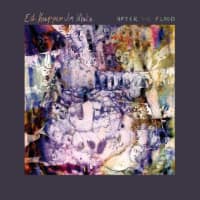As Ed dives into The Saints and Laughing Clowns’ songs, they are reimagined and turned upside down. While some artists get in a habit of just covering their older material as it was recorded, Kuepper takes the creative and challenging approach (as Bob Dylan does) and reinvents it, bringing the songs into the present.
His teaming with Jim White now appears to be an obvious choice. White is arguably one of the most creative percussionists and drummers Australia has produced. Cat Power is quoted as saying: “Jim has an ability to master any set and in any situation. You can hear a rainbow of emotions in the in swells the droplets, the attacks. I don’t know anyone that can do that.” Whether it’s working with Cat Power, Dirty Three or Xylouris White,. Jim White is singularly gifted.
So to this album and “The Ruins” (from the Kuepper album “Lost Cities”) opens. It has an ambience of being live and loose while Kuepper and White find a groove as the song finds form. Like many of the songs on this album, it’s gentle with some forbidding imagery. Ed’s voice has never sounded so in control; his phrasing and crooning is at one with the stunning guitars. The interplay between drums and guitars is sublime.
“The Crying Dance” is a song from the Laughing Clowns in 1982. The Laughing Clowns changed my life, musically. Yes, I was into The Saints. It was a bitterly cold winter’s night when I saw them. I’d gotten a lift with some bloke I was doing the HSC with to see them play a live-to-air for Double Jay. I’d never heard music like it. It expanded my mind. Like the Double Jay logo on the T-shirt, my head exploded.
I know a lot more about the Clowns now. They were one of the most original bands in Australia – no, the World. This band was the bastard son of Kraut Rock crossed with post-punk and John Coltrane. When I first caught them, Louise Elliott had just joined, taking centre stage with her sax solos. This was the band’s last gig before heading to Europe.
It was still the Sydney of Radio Birdman and garage rock. The Clowns were in their own universe. The darkness and complexity of Laughing Clowns were something most people had not heard before.
“The Crying Dance” here is substantially reworked and seems more brutal and powerful when stripped down to just guitar and drums. If anything, there’s more intensity.
“The Year of The Bloated Goat” is another re-worked Laughing Clowns song from “Mr Uddich Schmuddich Goes To Town” and has been completely re-imagined, slowed down and pared back to plumb some darker depths I went back and played my Clowns records for comparison. It’s in Ed’s vocal delivery. Where he was once young and angst-ridden and had that classic punk sneer, now we find a warmer Kuepper and his voice has gathered more timbre.
“16 Days” is a sharp detour after all that dark intensity. The song is taken in almost an REM direction. There was a time when Ed’s music was actually on radio like Triple Jay. This is an exceptionally well-constructed rock ballad with Ed’s guitars melodic and augmented by arpeggios.
“Demolition” follows the gentler introspective tack with Jim White adding different percussive sounds to take song to a more ambient place. Its melodies soar with clattering sounds. It’s rendered in the same way Tom Waits avoids making a song sound radio friendly.
The almost takes to “Swing For The Crime” from “Prehistoric Sounds”. It’s twisted and gutted and brought back to life as a new type of beast. It has gained more of an edge (if possible) and the guitar-work highlights Ed’s prowess with a capo work in his tunings. The solo cuts in with raw intensity. Can you improve on a masterpiece? Ed has given the song a new depth.
Is it Ed’s dark humour at work in following “Swing For The Crime” with “Collapse Board”? Kuepper often declares, live. that “Collapse Board” is the most depressing song ever written. I’m not so sure about depressing, but the atmosphere conveyed here by his guitar lines is dark and the story told is forbidding, I always miss the bellowing saxophone by Louise Elliot when I saw the Clowns play this live, but Ed compensates with his guitars, and White’s drumming steers it well away from a standard backbeat.
The album finishes with “Miracles” from the “Jean Lee And The Yellow Dog” album and it’s a
soulfull, gentle take that breaks away from the drama and depth of darkness that the original explores. Ed’s music always lends itself to soundtracks and this one has a film-maker’s vision. Kuepper’s music is ambitious while at the same time working in his own universe, well away from trends that dictate radio airplay. It’s artistry.
Ed Kuepper is one the most inventive and creative guitarists in the country. You never hear his songs at a BBQ singalongs like those of Mossy or the Brewsters. He is a guitar player’s guitar player. You watch on to absorb his amazing talent. Jim White adds to the picture with empathy that takes songs to places that that they not previously entered. Every moment pf this album is precise and stunning.
Is it Ed Kuepper’s greatest work? Possibly. All this genius being captured in one session is an achievement. This album is a masterpiece.

 After The Flood - Ed Kuepper and Jim White (Remote Control)
After The Flood - Ed Kuepper and Jim White (Remote Control)